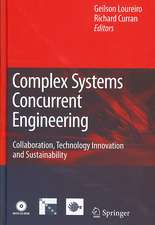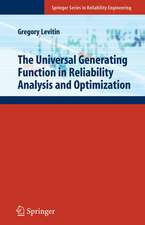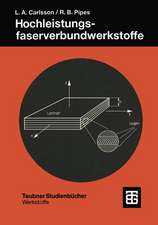Collaborative Product and Service Life Cycle Management for a Sustainable World: Proceedings of the 15th ISPE International Conference on Concurrent Engineering (CE2008): Advanced Concurrent Engineering
Editat de Richard Curran, Shuo-Yan Chou, Amy J. C. Trappeyen Limba Engleză Hardback – 18 aug 2008
| Toate formatele și edițiile | Preț | Express |
|---|---|---|
| Paperback (1) | 1832.22 lei 6-8 săpt. | |
| SPRINGER LONDON – 23 aug 2016 | 1832.22 lei 6-8 săpt. | |
| Hardback (1) | 1837.57 lei 6-8 săpt. | |
| SPRINGER LONDON – 18 aug 2008 | 1837.57 lei 6-8 săpt. |
Preț: 1837.57 lei
Preț vechi: 2240.94 lei
-18% Nou
Puncte Express: 2756
Preț estimativ în valută:
351.61€ • 368.10$ • 290.94£
351.61€ • 368.10$ • 290.94£
Carte tipărită la comandă
Livrare economică 05-19 aprilie
Preluare comenzi: 021 569.72.76
Specificații
ISBN-13: 9781848009714
ISBN-10: 1848009712
Pagini: 643
Ilustrații: XXII, 622 p.
Dimensiuni: 155 x 235 x 40 mm
Greutate: 1.04 kg
Ediția:2008
Editura: SPRINGER LONDON
Colecția Springer
Seria Advanced Concurrent Engineering
Locul publicării:London, United Kingdom
ISBN-10: 1848009712
Pagini: 643
Ilustrații: XXII, 622 p.
Dimensiuni: 155 x 235 x 40 mm
Greutate: 1.04 kg
Ediția:2008
Editura: SPRINGER LONDON
Colecția Springer
Seria Advanced Concurrent Engineering
Locul publicării:London, United Kingdom
Public țintă
ResearchCuprins
Collaborative Engineering.- Distributed Collaborative Layout Design in Service-Oriented Architecture.- Resolving Collaborative Design Conflicts Through an Ontology-based Approach.- Creating Value Within and Between European Regions in the Photovoltaic Sector.- Agent-based Collaborative Maintenance Chain for Engineering Asset Management.- Collaborative Engineering Systems.- Research on the Distributed Concurrent and Collaborative Design Platform Architecture Based on SOA.- Collaborative Architecture Based on Web-Services.- From Internet to Cross-Organisational Networking.- Grid-based Virtual Collaborative Facility: Concurrent and Collaborative Engineering for Space Projects.- Cost Engineering.- Cost CENTRE-ing: An Agile Cost Estimating Methodology for Procurement.- Cost of Physical Vehicle Crash Testing.- Estimating Cost at the Conceptual Design Stage to Optimize Design in terms of Performance and Cost.- Drone.- Design for Sound Transmission Loss through an Enclosure of a Generator Set.- Design Tool Methodology for Simulation of Enclosure Cooling Performance.- Using Virtual Engineering Techniques to Aid with Design Trade-Off Studies for an Enclosed Generator Set.- Sound Transmission Loss of Movable Double-leaf Partition Wall.- Modelling Correlated and Uncorrelated Sound Sources.- Interoperability.- Backup Scheduling in Clustered P2P Network.- Towards an Intelligent CAD Models Sharing Based on Semantic Web Technologies.- Towards a Multi-View Semantic Model for Product Feature Description.- Integrated Design.- Development of a Lightweight Knowledge Based Design System as a Business Asset to Support Advanced Fixture and Tooling Design.- Near Net-shape Manufacturing Costs.- Modelling the Life Cycle Cost of Aero-engine Maintenance.- Value Driven Design — an Initial StudyApplied to Novel Aerospace Components in Rolls-Royce plc.- Integrated Wing.- A Generic Life Cycle Cost Modeling Approach for Aircraft System.- Cost-Efficient Materials in Aerospace: Composite vs Aluminium.- A Multi-Fidelity Approach for Supporting Early Aircraft Design Decisions.- Cost Modelling of Composite Aerospace Parts and Assemblies.- Integrated Product Process Development (IPPD).- A Design Methodology for Module Interfaces.- Reducing the Standard Deviation When Integrating Process Planning and Production Scheduling Through the Use of Expert Systems in an Agent-based Environment.- Extracting Variant Product Concepts Through Customer Involvement Model.- QFD and CE as Methodologies for a Quality Assurance in Product Development.- Information Systems.- Integration of Privilege Management Infrastructure and Workflow Management Systems.- A Comparative Analysis of Project Management Information Systems to Support Concurrent Engineering.- Location-Aware Tour Guide Systems in Museum.- PDM — University Student Monitoring Management System.- Knowledge Based Engineering.- Multidisciplinary Design of Flexible Aircraft.- Service Oriented Concurrent Engineering with Hybrid Teams using a Multi-agent Task Environment.- Systems Engineering and Multi-disciplinary Design Optimization.- Application of a Knowledge Engineering Process to Support Engineering Design Application Development.- Knowledge Engineering.- Knowledge Based Optimization of the Manufacturing Processes Supported by Numerical Simulations of Production Chain.- Characterization of the Products Strategic Planning: a Survey in Brazil.- Using Ontologies to Optimise Design-Driven Development Processes.- CAD Education Support System Based on Workflow.- Configuration Grammars: Powerful Tools for Product Modelling in CADSystems.- Ontologies.- A Semantic Based Approach for Automatic Patent Document Summarization.- Develop a Formal Ontology Engineering Methodology for Technical Knowledge Definition in R&D Knowledge Management.- Ontologia PLM Project: Development and Preliminary Results.- Modelling and Management of Design Artefacts in Design Optimisation.- Premade.- A Quantitative Metric for Workstation Design for Aircraft Assembly.- An Integrated Lean Approach to Aerospace Assembly Jig and Work Cell Design Using Digital Manufacturing..- The Effect of Using Animated Work Instructions Over Text and Static Graphics When Performing a Small Scale Engineering Assembly.- Digital Lean Manufacture (DLM): A New Management Methodology for Production Operations Integration.- Sustainability.- Simulation of Component Reuse Focusing on the Variation in User Preference.- Evaluation of Environmental Loads Based on 3D-CAD.- Proposal of a Methodology Applied to the Analysis and Selection of Performance Indicators for Sustainability Evaluation Systems.- Ocean Wave Energy Systems Design: Conceptual Design Methodology for the Operational Matching of the Wells Air Turbine.
Textul de pe ultima copertă
The recognized requirement for advancements in Concurrent Engineering for sustainable productivity enhancement (improved quality of life) can be viewed positively. The basic aim of productivity enhancement is changing, from primarily seeking collaborative enterprise engineered solutions through a more restricted short-term market view. Rather, it is looking forward to a more expansive truly concurrent engineering approach to development that must be adopted in order to synthesize all of the far-reaching requirements and implications relating to products and their intended operation, service provision and end-of-life. It is already evident in this new century that the desire for sustainable development is increasingly driving the market to reach for new and innovative solutions that more effectively utilize the resources we have inherited from previous generations; with the obvious responsibility to future generations.
There is a need to rethink the way in which we make things in order to revise the ‘cradle to grave’ philosophy of the industrial revolution, which can be viewed as an extreme relative to nature’s principle of sustainable evolution. Human productivity and progress can be positively engineered and managed in harmony with the provision and needs of our natural environment. One century on from the industrial revolution, this is now the time of the sustainable revolution; requiring holistic technological, process and people integrated solutions to sustained socio-economic enhancement. It might surprise Albert Einstein that he rather well encapsulated the nature of this ‘evolutionary struggle’ when he stated: "The world will not evolve past its current state of crisis by using the same thinking that created the situation".
Collaborative Product and Service Life Cycle Management for a Sustainable World gathers together papers from the 15th ISPE International Conference on Concurrent Engineering (CE2008),to stimulate the new thinking that is so crucial to our sustained productivity enhancement and quality of life.
There is a need to rethink the way in which we make things in order to revise the ‘cradle to grave’ philosophy of the industrial revolution, which can be viewed as an extreme relative to nature’s principle of sustainable evolution. Human productivity and progress can be positively engineered and managed in harmony with the provision and needs of our natural environment. One century on from the industrial revolution, this is now the time of the sustainable revolution; requiring holistic technological, process and people integrated solutions to sustained socio-economic enhancement. It might surprise Albert Einstein that he rather well encapsulated the nature of this ‘evolutionary struggle’ when he stated: "The world will not evolve past its current state of crisis by using the same thinking that created the situation".
Collaborative Product and Service Life Cycle Management for a Sustainable World gathers together papers from the 15th ISPE International Conference on Concurrent Engineering (CE2008),to stimulate the new thinking that is so crucial to our sustained productivity enhancement and quality of life.
Caracteristici
The proceedings of the 15th ISPE International Conference on Concurrent Engineering (CE2008) Stimulates the new thinking that is so crucial to our sustained productivity enhancement and quality of life Includes supplementary material: sn.pub/extras















